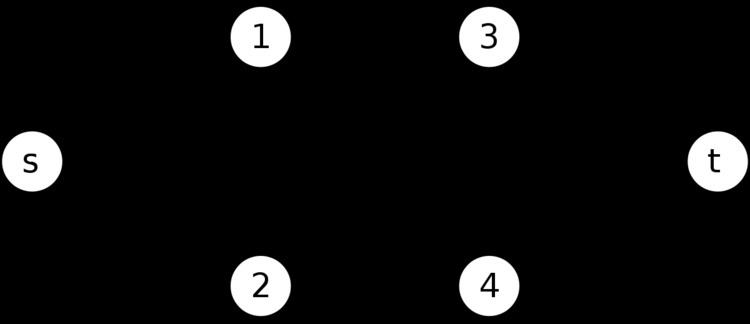 | ||
Dinic's algorithm or Dinitz's algorithm is a strongly polynomial algorithm for computing the maximum flow in a flow network, conceived in 1970 by Israeli (formerly Soviet) computer scientist Yefim (Chaim) A. Dinitz. The algorithm runs in
Contents
History
Yefim Dinitz invented this algorithm in response to a pre-class exercise in Adel'son-Vel'sky's (co-inventor of AVL trees) Algorithm class. At the time he was not aware of the basic facts regarding Ford-Fulkerson algorithm.
Dinitz mentions inventing his algorithm in January 1969, which was published in 1970 in journal Doklady Akademii nauk SSSR. In 1974, Shimon Even and (his then Ph.D. student) Alon Itai at the Technion in Haifa were very curious and intrigued by the Dinitz's algorithm as well as Alexander Karzanov's idea of blocking flow. However it was hard to decipher these two papers for them, each being limited to four pages to meet the restrictions of journal Doklady Akademii nauk SSSR. However Even did not give up and after three days of effort managed to understand both papers except for the layered network maintenance issue. Over the next couple of years, Even gave lectures on "Dinic's algorithm" mispronouncing the name of the author while popularizing it. Even and Itai also contributed to this algorithm by combining BFS and DFS, which is the current version of algorithm
For about 10 years of time after Ford–Fulkerson algorithm was invented, it was unknown if it can be made to terminate in polynomial time in the generic case of irrational edge capacities. This caused lack of any known polynomial time algorithm that solved max flow problem in generic case. Dinitz algorithm and the Edmonds–Karp algorithm, which was published in 1972, independently showed that in the Ford–Fulkerson algorithm, if each augmenting path is the shortest one, the length of the augmenting paths is non-decreasing and it always terminated.
Definition
Let
- if
( u , v ) ∈ E ,c f ( u , v ) = c ( u , v ) − f ( u , v ) c f ( v , u ) = f ( u , v ) -
c f ( u , v ) = 0 otherwise.
Algorithm
Dinic's Algorithm
Input: A network- Set
f ( e ) = 0 for eache ∈ E . - Construct
G L G f G . Ifdist ( t ) = ∞ , stop and outputf . - Find a blocking flow
f ′ G L - Augment flow
f byf ′
Analysis
It can be shown that the number of layers in each blocking flow increases by at least 1 each time and thus there are at most
Using a data structure called dynamic trees, the running time of finding a blocking flow in each phase can be reduced to
Special cases
In networks with unit capacities, a much stronger time bound holds. Each blocking flow can be found in
In networks arising during the solution of bipartite matching problem, the number of phases is bounded by
Example
The following is a simulation of Dinic's algorithm. In the level graph
